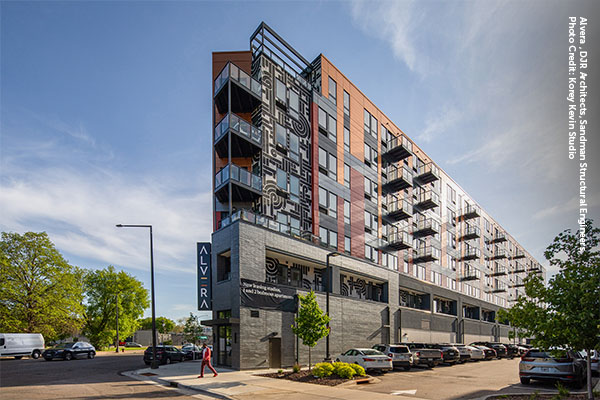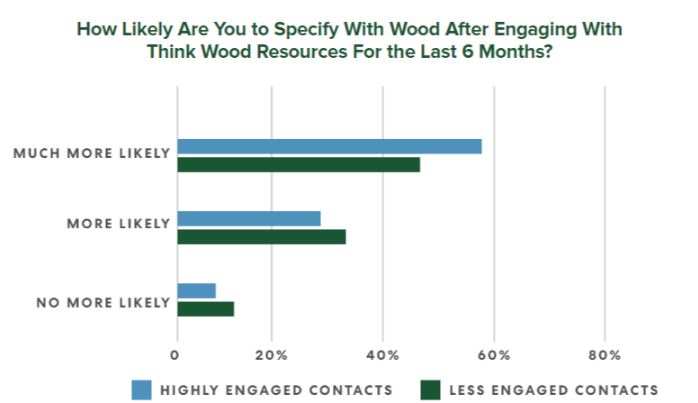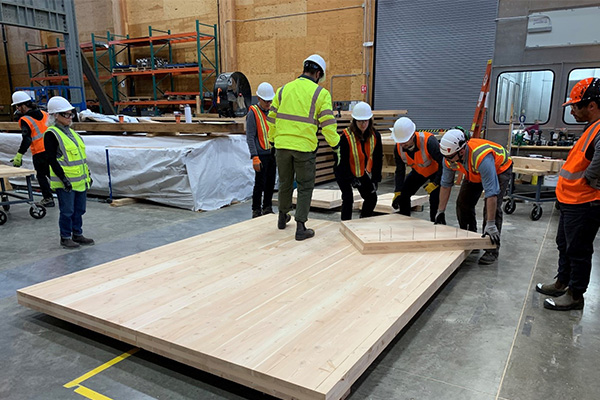HIGHLIGHTS
Program Updates
Education and Support Encourage Innovative Light-Frame Projects

Sixty-six percent of WoodWorks’ 2023 reported projects were light-frame wood, a construction type that is tried-and-true, with light-frame projects making up 86% of the wood market for non-residential and multifamily buildings, according to Forest Economic Advisors’ 2024 U.S. Outlook.
Light-frame construction is also complex and evolving as design teams use it for taller and more advanced applications. WoodWorks supports issues ranging from detailing to code compliance, accommodating shrinkage, and the nuances of light-frame/mass timber hybrids. As with all construction types, WoodWorks’ staff facilitates these innovative light-frame projects with a mix of one-on-one support, education, and resources—giving practitioners direct information where needed, along with the knowledge and tools to resolve future issues independently.
In 2023, for example, WoodWorks hosted or spoke at 129 events featuring innovative light-frame topics that attracted a total of 13,143 attendees. Adding to these numbers, WoodWorks events also include many blended sessions covering both light-frame and mass timber topics. WoodWorks strives to provide a balanced education lineup that is relevant across audiences, building types (multifamily, institutional, commercial), and wood products, demonstrating the value of wood generally and reinforcing the message that there is a cost-effective wood solution to almost any project. This approach helped propel WoodWorks to nearly 80,000 education hours in 2023—a program record.
New Design Standards Ensure Codes Remain Favorable to Wood Products
AWC staff and committees completed five years of work in November when the program released five new design standards and supporting documents that are referenced in the 2024 International Code Council (ICC) I-codes.
- ANSI/AWC NDS-2024: National Design Specification (NDS) for Wood Construction
- 2024 NDS Supplement
- ANSI/AWC WFCM-2024: Wood Frame Construction Manual for One- and Two-Family Dwellings
- 2024 Span Tables for Joists & Rafters (STJR)
- 2024 Design Values for Joists & Rafters (DVJR)
The AWC’s work in the building code development process helps ensure the broad acceptance of wood products in the approved national model building codes, which set the minimum requirements for how structural systems and the many other aspects of residential and commercial buildings should be designed and constructed in the United States. By ensuring that building codes and standards remain receptive and favorable to wood, the AWC’s work helps to grow a strong market for softwood lumber and reduce barriers to specification.
That work will continue for future building code cycles. The AWC has introduced a series of code change proposals to the 2027 ICC model code to add references to its newly release fire design standard, ANSI/AWC FDS-2024: Fire Design Specification for Wood Construction, in a process that will continue for the next three years. The AWC has also begun updating additional design standards, including the Special Design Provisions for Wind and Seismic (SDPWS), to include a wood structural panel shear wall system that could help meet ever-increasing seismic loading requirements. The changes could open up new opportunities for wood products in seismic regions like California, as well as for wood-frame buildings with lots of exterior glass—a feature in demand among architects.
Survey Confirms Think Wood’s Positive Impact on Specification

Design professionals who are more engaged with Think Wood content are also more likely to specify wood in their projects, a recent survey found—a promising result with Q4 2023 landing as the most productive quarter in the history of the campaign for new content.
Think Wood surveys its database contacts every six months about their use of wood as a structural material, dividing the results into two segments: contacts with less engagement and more-engaged contacts. The survey found that 71% of the more-engaged audience is likely or very likely to specify wood in an upcoming project, compared with 64% of the less-engaged category, demonstrating the program’s effectiveness at creating resources that support the audience’s journey toward specification.
The survey respondents’ self-reported use of wood in the past year points to the same conclusion. In both Q2 and Q4, about 75% of the more-engaged users had used light-frame wood construction in the last 12 months, compared with 60% of the less-engaged. Overwhelmingly, both groups said interacting with Think Wood resources makes them more likely or much more likely to specify wood (see chart above). The survey also provides valuable insights on the resources and topics valued most by the audience. Think Wood is using the results to shape editorial strategy in 2024, such as with project case studies designed to share lessons for a user base that knows how to employ wood and is looking to improve.
Driving Change: SLB-Funded Workshop Creates Faculty Experts to Push Wood Education Growth

Building on a successful series of SLB-funded faculty engagements in 2023, SLB Education’s first faculty workshop of 2024 was held at Oregon State University’s Tall Wood Design Institute in January. For the first time, the event took an interdisciplinary approach, providing tenure-track architecture and engineering faculty with a hands-on intensive immersion to mass timber design, digital fabrication, and construction processes. The 14 faculty members from 12 institutions worked through a practical design-build exercise, designing a small-scale mass timber pavilion, integrating design thinking with fabrication and constructability considerations.
Investing in the development of early-career architecture and engineering faculty is a strategic initiative that amplifies SLB’s immediate impact. Faculty equipped with the latest knowledge and practical skills in wood design and construction are catalysts for growth, shaping the next generation of architects and engineers and fostering a future workforce that is proficient in the economic and environmental advantages of wood construction. SLB-funded workshops expose younger faculty to the very leading edge of wood construction, strengthening their CVs and elevating their careers toward tenured positions—creating a multiplier effect as their influence can further ingrain wood curriculums into programs across the country.
The highlight of the workshop for participants was assembling the CLT panels to create the final structure, which will be displayed on campus at OSU and at the International Mass Timber Conference in Portland, Oregon, in March. This investment in faculty helps them nurture a talent pipeline of architecture and engineering students who will not only be exposed to wood as a material choice for contemporary design challenges but will also have the capacity, and confidence, to specify wood solutions effectively. Four additional workshops are planned for 2024.
If you currently serve in an advisory function at a university, contact Director of Education Reed Kelterborn at rkelterborn@softwoodlumberboard.org to explore collaboration.
Spotlight
Investors Reinforce Economic and Environmental Value of Wood Products

The SLB works to influence public perception about forestry and the wood products industry through its investments in the AWC and the Working Forests Initiative. These organizations help shape opinion to drive broad acceptance of wood products, reducing barriers to adoption.
In some cases these organizations themselves become thought leaders, such as Rachael Jamison, the AWC’s Vice President of Markets & Sustainability, who has appeared on podcasts and in a documentary film to speak about the sustainable value of wood in construction. In other cases, the SLB’s investors can also become thought leaders, especially in their local community, to reinforce the messaging developed by the AWC and the WFI.
The SLB’s Board Chair, Westervelt’s former CEO Brian Luoma, took the opportunity to do so when he appeared on PBS’s America’s Heartland series earlier this year. Westervelt took producers on a tour of the company’s high-tech mill, and in an interview, Luoma emphasized both the positive economic impact of the timber industry and his company’s role as a steward of the forest, echoing messages used by the WFI.
“The beauty of the way forestry works in the South is that the soils here and the land here is really suited for growing trees and growing trees and harvesting trees, and then growing them again,” he said.
Industry Resources
FEA's Housing Dashboard
This housing dashboard is provided compliments of Forest Economic Advisors (FEA)
View the January Housing Dashboard

